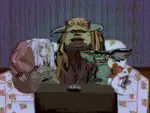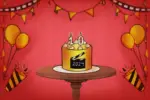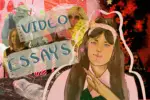On March 22, 2024, “Late Night With the Devil” was released in movie theaters nationwide. Over the past few months, the film has amassed interest from critics and the general public alike on many fronts. Namely, its status as a long-awaited vehicle for character actor David Dastmalchian and its campy premise, which essentially boils down to “what-if ‘The Exorcist’ happened live on ‘Johnny Carson?’”
The film has a unique and finely tuned ‘70s television aesthetic, with imagery and set design reminiscent of shows like “The Tonight Show with Johnny Carson” movies like “Network.” Its trailer alone bleeds a genuine love of filmmaking (no pun intended). All in all, it struck many horror fans as a breath of fresh air.
Unfortunately, the first “Late Night With the Devil” promos contained an unintentional scare: the use of generative AI for certain graphics in the film.
On Wednesday, February 7, 2024, after one of the film’s earliest promos went up, Reddit user u/loraximus907 posted about their disappointment that an AI graphic appeared in the video. The image in question was a retro-style skeleton dancing among a pumpkin patch, evoking the feeling of an old “We’ll be right back” end card that might appear between commercial breaks.
The hallmark mangled hands of the skeleton and garbled dream imagery of the pumpkins clued viewers into its artificially generated status. However, there was still a mixed consensus on whether this was controversial. When the movie came out in March, and the graphic showed up multiple times throughout the film, public opinion solidified in the mainstream.
Frustrated reviews poured in, and the film trended on Twitter for hours. For a few days, the subject of AI dominated all online discussion of the film, both in niche horror circles, like the Shudder subreddit, and at mainstream outlets, such as Forbes or Entertainment Weekly.
A large part of the debate was about whether the outrage was warranted. And, if it is, what are the viewers supposed to do about it? According to a statement released by directors Cameron and Colin Cairnes, the film only used three AI-generated images.. They claimed that any AI-generated images in the movie were also “edited further” by their artistic team before appearing in the final product.
The issue is more complicated because the film started production in February 2022, long before either the WGA or SAG-AFTRA began their strikes and definitely before artists’ grievances with AI were documented and codified in Hollywood.
Such production nuances make the problem grayer than most AI issues have been recently, so responses were mixed. Some people called for a boycott, concerned about the dangerous precedent the film’s use of AI might set for the future if it goes unaddressed. With the recent push from companies like OpenAI for more AI usage in Hollywood, its presence in film currently feels understandably prescient.
On the other hand, some critics argue that this movie could open the door for more well-made and original indie movies—something cinephiles have been hungry for. Perhaps “Late Night With the Devil” could lead to more prestige horrors getting past the studio stranglehold that’s overtaken the industry in the last decade. Artistic desires aside, there’s also the fact that an entire cast and crew worked on the film, and many people believe their efforts should outweigh the comparatively tiny amount of AI-generated content in the movie.
One of the most disappointing aspects of this, a point that’s fallen by the wayside, is how severely the usage of AI detracts from the film itself. As a period piece, “Late Night With the Devil” takes great pains to imitate its source material. Its makeup, set design, soundtrack, and even shooting style are all utterly believable within the context of the 1970s. There’s even art earlier in the film that was intentionally commissioned, carefully and deliberately designed by a person to look like a ‘70s magazine.
So the question remains: why go through all that trouble for what is clearly a beloved passion project just to deflate it with such an obviously artificially generated graphic in the middle? As far as moviegoing experiences go, any viewer with basic technological literacy is immediately surprised.
The answer is still unknown. The filmmakers’ statement on their own AI usage is vague. While there has been speculation that the technology was used last minute, due to its minimal presence in the film, no one can honestly know the motivations and intentions behind it. However, the decision has muddled the legacy of a well-crafted film that was shaping up to be an industry hero. Though it is looking unlikely, we can only hope that we don’t see more of this in the future.

















